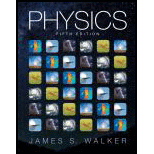
Concept explainers
The brief description of the Ultraviolet Catastrophe.
Answer to Problem 1CQ
Explanation of Solution
Ultraviolet Catastrophe is a classical prediction and is also known as Rayleigh–Jeans catastrophe.
Here the term Ultraviolet refers to the fact that the problem appears in short wavelength region of
Ultraviolet Catastrophe predicts that an ideal black body at thermal equilibrium will emit radiation in all frequency ranges and it emits more energy when the value of frequency increases with infinite power.
The expression for the energy is,
Here,
The above equation can explain the energy distribution curves for longer wavelengths satisfactorily, but fails to explain the curves for smaller wavelengths.
Integrate the above equation from zero to infinity.
Conclusion:
Therefore, Ultraviolet Catastrophe is an event causing great and usually sudden damage or suffering when an ideal black body at thermal equilibrium emits radiation with infinite power.
Want to see more full solutions like this?
Chapter 30 Solutions
Physics (5th Edition)
- calculate the ratio of eddusion rates for krypton and xenon gasses 0.637 : 1 1.25 : 1 1.57 : 1 or 0.799 : 1arrow_forwardFor a star with the same radius as the Sun, but with a mass twice that of the Sun; a) What is the average pressure lower limit value? b) What is the lower limit value for the average temperature according to the minimum and maximum limit values of the average molecular weight?arrow_forwardIf the emitted infrared radiation from Pluto, has a wavelength of maximum intensity at 75,000 nm, what is the temperature of Pluto assuming it follows Wien’s law?arrow_forward
- Describe the relationship between particle-wall collisions and pressure.arrow_forwardsolar radiation power 3.95 * 10 ^ 33 erg.cm ^ (- 2) T ^ (- 4) effective temperature 5700 K, apparent brightness -26 ^ m.7 absolute brightness 4 ^ mg, the angular diameter of the sun (a) What is the linear radius (R) and the earth-sun distance (d)?arrow_forwardAssuming that the Sun is a blackbody with a temperature of 6,000 K, at what wavelength does it radiate the most energy? [4.8 x 10‐7 m]arrow_forward
- A section of superconducting wire carries a current of 100 A and requires 1.00 L of liquid nitrogen per hour to keep it below its critical temperature. For it to be economically advantageous to use a superconducting wire, the cost of cooling the wire must be less than the cost of energy lost to heat in the wire. Assume that the cost of liquid nitrogen is $0.30 per liter, and that electric energy costs $0.10 per kW·h.What is the resistance of a normal wire that costs as much in wasted electric energy as the cost of liquid nitrogen for the superconductor?arrow_forwardMidterm G Which of the following cc locs.google.com/forms/d/e/1FAlpQLSehenyKBfzpwA6Ba1LyJILHfOLpHNWF menian America... yyyyyyyyyu E Untitled document -. Alpha particles are electrons helium nuclei negative neutral When an elecuon movesarrow_forwardEstimate the thermally Doppler-broadened line widths for the hydrogen Lya, C III, O VI, and Mg X lines are given below; use the temperatures provided. Take the masses of H, c, O, and Mg to be 1 u, 12 u, 16 u, and 24 u, respectively. The 121.6-nm Lyman-alpha (Lya) emission line of hydrogen (n=2 →n =1) is produced at the top of the chromosphere at 20,000 K, the ClII 97.7-nm line originates at a level where the temperature is 90,000 K, the 103.2-nm line of O VI occurs at 300,000 K, and Mg X creates a 62.5-nm line at 1.4 x 106 K.arrow_forward
- /dsinė A beam of electrons is shot towards a material X with a crystalline structure. A diffraction pattern is observed corresponding to a distance d=0.15 nm. between two adjacent Bragg planes. The electrons are each sent in with a kinetic energy of 51.900000000000006 eV. Part a) Find the de Broglie wavelength in nanometres of an electron incident on the material X.arrow_forwardAssuming Suns surface temperature as 5779 K calculate the maximum wavelength emitted by the Sun?arrow_forwardHow would you calculate what is the percentage of the blackbody radiation from a source at 300 K in the wavelength region from 8 to 14 um? (This is the so-called window in the earth's atmosphere.) Do not solve it numerically just explain how you would solve it (write the necessary equation).arrow_forward
 Foundations of Astronomy (MindTap Course List)PhysicsISBN:9781337399920Author:Michael A. Seeds, Dana BackmanPublisher:Cengage Learning
Foundations of Astronomy (MindTap Course List)PhysicsISBN:9781337399920Author:Michael A. Seeds, Dana BackmanPublisher:Cengage Learning Stars and Galaxies (MindTap Course List)PhysicsISBN:9781337399944Author:Michael A. SeedsPublisher:Cengage Learning
Stars and Galaxies (MindTap Course List)PhysicsISBN:9781337399944Author:Michael A. SeedsPublisher:Cengage Learning
 AstronomyPhysicsISBN:9781938168284Author:Andrew Fraknoi; David Morrison; Sidney C. WolffPublisher:OpenStax
AstronomyPhysicsISBN:9781938168284Author:Andrew Fraknoi; David Morrison; Sidney C. WolffPublisher:OpenStax Modern PhysicsPhysicsISBN:9781111794378Author:Raymond A. Serway, Clement J. Moses, Curt A. MoyerPublisher:Cengage Learning
Modern PhysicsPhysicsISBN:9781111794378Author:Raymond A. Serway, Clement J. Moses, Curt A. MoyerPublisher:Cengage Learning




